AUTUMN COLORS
No doubt Tom Caruso of Smithtown was struck by the gorgeous color of these mums before he snapped this photo at a farm stand in East Setauket.
Send your Photo of the Week to [email protected].
AUTUMN COLORS
No doubt Tom Caruso of Smithtown was struck by the gorgeous color of these mums before he snapped this photo at a farm stand in East Setauket.
Send your Photo of the Week to [email protected].
By Judie Gorenstein
Will you be using your power on Nov. 6 or abdicating it to others? Voting is not only a right but a responsibility. Yet in New York voter turnout is exceptionally low: 49th out of all 50 states in 2014 at 28 percent of eligible voters. But this year’s September primary drew twice as many voters as 2014, so with your participation we can similarly do more than double 2014’s numbers.
What do you need to know to be not only a voter but an educated one? You can check your registration details at the Board of Elections www.SuffolkVotes.com website, including your polling site and if you are enrolled in a party. If you know you are registered but your name is not there, call Suffolk BOE at 631-852-4500 to resolve any issue. October 12 is the deadline for voter registration in New York State this year. Libraries and post offices have forms and they’re also online at www.SuffolkVotes.com and should be mailed to the Suffolk BOE.
Will you be out of the county for work, school or vacation and unable to get to the polls on Nov. 6? Does a disability or hospital or rehabilitation stay prevent you going to the polls? Are you a primary caregiver and unable to vote in person? If so, you can vote on an absentee ballot. This is a two-step process. Apply for an absentee ballot by picking up a copy as described above for voter registration form, filling out the request and mailing it to the BOE by Oct. 30.
The BOE will mail you your ballot in time for you to complete and mail back to the BOE by Nov. 5. If after you vote on an absentee ballot and then you find you can and want to vote at the polls, you MAY and your absentee ballot will not be counted. Absentee ballots are counted days after the polls close when the BOE can compare them to signatures in poll books. However, be assured if you are not able to vote on Election Day and your absentee ballot was completed correctly, it will be counted.
For those who find out after Oct. 30 that they cannot get to the polls on Nov. 6, the Suffolk BOE will be open during the weekend before Election Day. You can go to the BOE at 700 Yaphank Ave. in Yaphank and vote on an absentee ballot, which will be counted as the others are. Check its website or call the BOE to find the days and hours.
This year in Suffolk County, we will be electing our representatives in Congress (Suffolk includes all or part of the 1st, 2nd and 3rd CDs), one U.S. senator, NYS governor, NYS lieutenant governor, NYS attorney general, NYS comptroller, NYS senators, NYS assemblypeople, Suffolk County comptroller, Suffolk County clerk and Suffolk County judges. Depending on your area, there may also be special town elections or local propositions on your ballot.
Knowing who is on your ballot and learning about the candidates before you get to the polls is vital. An excellent nonpartisan data aggregation service is www.BallotReady.org, which not only gives you the candidates on your ballot but provides background information on the candidates and their stances on major issues, who is endorsing them and, if you choose, will also send you a reminder to vote. You can access it at www.VotingNewYork.org.
When possible see and hear the candidates in person at candidate forums, debates and events. Try to find out whether the event is sponsored by a nonpartisan group in order to get a fair perspective. The press, websites and other media have lots of useful information but most do endorse candidates or represent political party perspectives. Educate yourself and encourage others to do so. You’ll all learn more, and sharing insights and facts will broaden everyone’s view and motivate all to be voters.
Your vote is your power. If you go to the polls Nov. 6 and find your name omitted from the poll book, ask for an affidavit ballot (also called provisional ballot). Never ever leave a poll site without voting! Provisional ballots, just like absentee ballots, are counted at the Suffolk County BOE after Election Day, and elections are not certified until they are all reviewed. Make your choice count … be a voter!
Judie Gorenstein is vice president for voter services of the League of Women Voters of Suffolk County, a nonprofit, nonpartisan organization that encourages the informed and active participation of citizens in government and influences public policy through education and advocacy. For more information, visit https://www.lwv-suffolkcounty.org, email [email protected] or call 631-862-6860.
By Heidi Sutton
Back by popular demand, the North Shore Artist Coalition will host its 2018 Open Studio Tour this weekend, Oct. 13 and 14, from 11 a.m. to 5 p.m. The free event will showcase the studios of 15 award-winning artists in Setauket, Stony Brook, Port Jefferson and St. James.
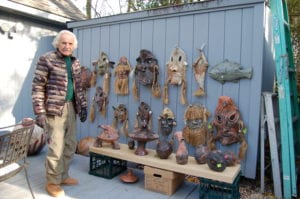
The coalition, whose founding members include Pam J. Brown, Jim Molloy, Doug Reina, Mary Jane van Zeijts and Nancy Bueti-Randall, started this tour three years ago with the goal of bringing more awareness to professional artists that are living in the Three Village area.
“We felt that by coming together and pooling our talents and ideas that we could have some kind of creative impact in the community and the studio tour was one of those ideas,” said Reina in a recent interview. “It’s nice to do this with like-minded people.”
While Molloy will be unable to participate this year, the group has invited artists Al Candia, Peter Galasso, Sungsook Hong Setton, Christian Stuyvesant White, Hugh J. McElroy, Marlene Weinstein, Christine Mannone Carolan, Cindy Crowell, Leslie M. Cross, and mother/daughter duoFlo and Karen Kemp to join them for the weekend event. “It’s good that they’re on board. They’re good artists and I know they’re excited to be part of this,” said Reina.
Reached by phone, Brown said visitors to the event “can expect to see the works of an eclectic mix of professional artists who are illustrators, photographers, sculptors and painters.” Most importantly, she said, the tour will offer an intimate look into their art studio.
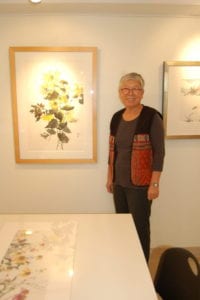
That, said Reina, is what makes this event so unique. “Honestly, how often do you get to see the inner workings of an artist’s creative process?” he asked. “Usually you see the paintings hanging up [in a gallery] but you don’t really get a chance to see where the artwork gets created.” The Setauket artist added that those that “are at all interested in the technical part of art or getting into art or becoming a little bit more serious about your art” would benefit from this tour.
Finished works as well as works in progress will be on view and several artists will be giving demonstrations.
In the two previous tours, each artist welcomed 80 to 100 visitors to their studio and Brown is excited to see what the future holds.
“People go to Gallery North, there’s the Reboli Center, the Setauket Artists, Neil Watson at The Long Island Museum is doing unbelievable things, we now have the Brick Studio, we have The Atelier at Flowerfield and then you have the Mills Pond Gallery. That’s a lot of art organizations — there’s a lot happening — so I think it’s really great for local artists to be connected as much as possible and build our community and try to build awareness for people outside of our community,” she explained.
“We would love in the future to have all these local organizations on board so this becomes a big cultural attraction, an art destination for people who are looking to get away for the weekend,” Brown continued. “It is my hope that this event continues to grow.”
The Artist Open Studio Tour map and addresses may be found at https://www.facebook.com/NorthShoreArtistCoalition. Admission is free and refreshments will be served at some of the studios. For further information, please call 631-834-9036.
By Heidi Sutton
With Halloween just around the corner, Theatre Three has all the bases covered. While mature audiences enjoy a creepy and spooky “The Addams Family,” young theatergoers can have fun as well with an adorable show titled “A Kooky Spooky Halloween.” The original musical written by Jeffrey Sanzel and Steve McCoy returns to the theater for the second year in a row through Oct. 27.
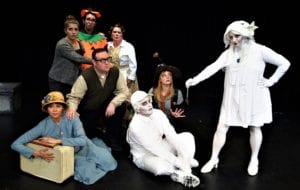
The story centers around a friendly ghost named Abner (Steven Uihlein) who has just graduated from Haunting High School and is given a medallion of invisibility. Abner is immediately assigned to haunt Aberdeen’s Boarding House, famously known for being the most haunted house in Harrison County U.S.A and for serving the best toast. There are only two rules he has to follow — he can only haunt at night and he can’t lose the medallion or he’ll be seen by the living.
But Abner has a secret — he is afraid of the dark, which is “like a vampire who’s afraid of necks!” according to his best friend Lavinda the Witch (Michelle LaBozzetta). She promptly gives him a night-light to wear and promises to help him with his haunting duties.
When Abner and Lavinda arrive at the boarding house, they find Ma Aberdeen (Ginger Dalton), the finest toast maker in the land, and her boarders, Kit Garret (Nicole Bianco) and the Petersons — Paul the periodontist (Andrew Lenahan), his wife Penelope (Chrysovalantou Tsoumpelis) and their son Pip (Eric J. Hughes), whose alliterations using words that start with the letter P are positively perplexing, in the kitchen getting ready for Halloween.
When Pip puts on a pumpkin pullover and starts to tell pumpkin jokes (okay I’ll stop), Abner puts a speed spell on the group, making them stuff Halloween goodie bags, do jumping jacks, quack like a duck, sing and dance in fast motion. He then casts a spell to make them get stuck to each other.
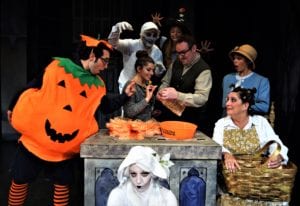
In a sudden twist of events, fellow graduate and ghost with a grudge Dora Pike (Beth Ladd) shows up and steals Abner’s night-light and medallion of invisibility and hides them in Black Ridge Gulch, the deepest, darkest gorge in the entire world (where it’s really, really dark). Now visible, Abner must try to convince the boarders, who are still stuck to each other, to help him and Lavinda get his property back. Will they help him? And will Abner be able to overcome his fear of the dark?
Directed by Sanzel, the eight-member adult cast delivers an energetic performance that touches on the power of friendship and the importance of helping others.
Accompanied on piano by Douglas Quattrock and choreographed by Bianco, the song and dance numbers are terrific, especially “Into the World I Go” by Abner, the downright creepy “It Will All Fade to Black” by Dora, the sweet “A Witch Is a Person” by Lavinda and the fun group number, “It’s Ma Who Makes the Toast.”
The end result is a hauntingly fun afternoon that children and parents will love.
Snacks and beverages are available for purchase during intermission and booster seats are available. Costumes are encouraged and souvenir cat, pumpkin, vampire and ghost dolls will be available for purchase before the show and during intermission for $5. Meet the cast in the lobby for photos on your way out.
Theatre Three, 412 Main St., Port Jefferson will present “A Kooky Spooky Halloween” through Oct. 27. Children’s theater continues with “Barnaby Saves Christmas” from Nov. 23 to Dec. 29. All seats are $10. To order, call 631-928-9100 or visit www.theatrethree.com.
All photos by Peter Lanscombe, Theatre Three Productions Inc.
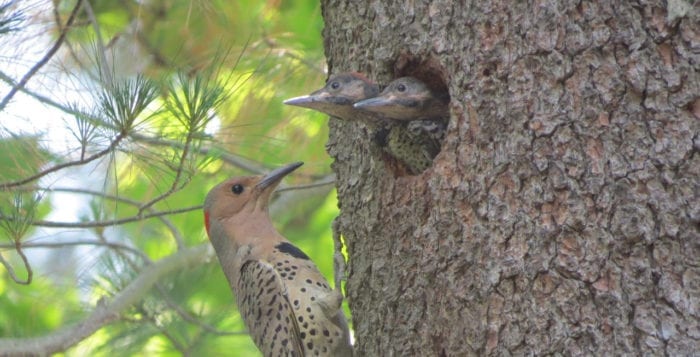
By John Turner
When it comes to cavities it’s all about the type. A large cavity in your molar? A trip to the dentist because it’s a problem you need to have treated immediately. A deep cavity in the road you travel on the way to the dentist? Worth a phone call to the superintendent of highways before it destroys tires and rims.
But cavities in a living white oak or dead pitch pine in an unused back corner of your property? Priceless assets appreciated by many species of birds, mammals and insects that nest or roost in them. This point is emphasized by the fact that more than 60 North American birds, mammals and reptiles use tree cavities of various sizes to roost or nest in, underscoring their fundamental importance in maintaining ecological balance.
Cavity-using bird species include black-capped chickadees (a tiny bird beloved by many), titmice, nuthatches, screech owls (fairly common in the woodlands of the Three Village area), all species of woodpeckers, a few ducks, several species of bats, gray and flying squirrels, raccoons, opossums, mice and several species of tree-climbing snakes. Add to this many dozens of insects including bees that use cavities too.
Cavities are such coveted features that species often compete for them. I once watched a several-days battle take place at my house between two woodpecker species — a red-bellied woodpecker and a northern flicker — and a European starling, all vying for a cavity in a large red maple tree on the far edge of the driveway, observable from a second-story window. The flicker had established first rights to it but was usurped by a pair of starlings as the day went on. But with great drama the flicker fought back and the next day had reclaimed ownership. The skirmish continued and the starlings reclaimed it, but then the red-bellied showed up, evicting the starlings. The red-bellied was the final victor and subsequently raised a family in the maple tree.
Woodpeckers play a prominent role in the tree cavity rental market since they make and use so many cavities that other wildlife eventually use (others are created by decay through fungal rot such as when a branch breaks off at the main trunk).
The bigger woodpeckers — the aforementioned flicker and red-bellied — and the hairy and red-headed are especially adept in chiseling into the live wood to make cavities, the diminutive downy woodpecker not so much. Because of the cavity-making role woodpeckers play, and the reliance of so many wildlife species on cavities, woodpeckers are referred to as “ecological architects,” helping to shape the faunal composition of local forests.
Two cavity-nesting birds are worth mentioning. Eastern screech owls routinely use cavities and, in fact, are dependent on them for roosting and nesting. It is not unusual but always a delightful surprise to find one sitting at the entrance to a nest hole doing its best impression of tree bark. We have two different color morphs or forms — gray and rufous — and they are both cryptically colored. These small owls, which don’t screech but rather have a tremolo-like call, are probably found in every woodland patch of five acres or more in the area.
As mentioned earlier even some ducks use nesting cavities. Wood ducks, for example, nest in tree cavities, as do hooded mergansers, buffleheads and American goldeneyes. Hooded mergansers can be seen in the pond at Setauket’s Frank Melville Memorial Park during the winter and buffleheads in places like Setauket and Port Jefferson Harbor during the same time. Goldeneyes are winter ducks that are often seen floating on Long Island Sound. But wood ducks breed here and you might be lucky enough to see these spectacular looking birds (the male meets the avian definition of eye candy) at Frank Melville Park and other freshwater bodies in the area.
How do fluffy wood duck ducklings leave the cavity and follow their mother to the local pond to feed? You may have seen the answer on one of the nature shows on TV in which the babies, encouraged by the piping call of the parents, fearlessly launch themselves from the lip of the cavity into the air, making a 30- to 40-foot plunge to the ground below.
Many cavities are in trees that are dead or failing, although living trees sport their share. If the tree poses no danger to property or hasn’t the potential to land on your or your loved one’s head, consider leaving it in place. Not only might it become a wildlife condominium through time as it becomes pocked with cavities, it also becomes a cafeteria for wildlife. Many insects such as beetles are drawn to decaying wood, and they play a key role in recycling wood in forests, releasing nutrients and minerals to be used by living plants nearby. In the form of grubs, the beetles and other insects become food for birds.
So, if a dead tree, containing nesting cavities, presents a danger, by all means protect your head and house. But if it doesn’t threaten life or property, why not take a small step to protect your little area of planet Earth by leaving dead trees in place? You might even be rewarded by the call of a screech owl.
John Turner, a Setauket resident, is conservation chair of the Four Harbors Audubon Society, author of “Exploring the Other Island: A Seasonal Nature Guide to Long Island” and president of Alula Birding & Natural History Tours.
By Heidi Sutton
The Middle Country Public Library in Centereach hosted its 18th annual Women’s EXPO Oct.4. Thousands came out to kick off their holiday shopping at the one-day event which was presented by the Middle Country Library Foundation and the library’s Miller Business Resource Center.
More than 80 women entrepreneurs were given the opportunity to introduce their products, which included pottery, candles, baked goods, fall crafts, children’s books, clothing, jewelry, soaps and much more.
This year’s event’s lead sponsor was Bank of America and was also sponsored by Campolo, Middleton & McCormick, LLP of Ronkonkoma. Volunteers from Bank of America helped make sure the day ran smoothly.
“We had a great turnout with over 2,300 shoppers,” said Elizabeth Malafi, coordinator of Adult Services and the Miller Business Resource Center. “Year after year the best thing about the EXPO is the people. We are lucky to have amazing volunteers, entrepreneurs and shoppers who make it such a special day.”
Vendors interested in participating in next year’s event are encouraged to visit www.womensExpoli.org.
Photos by Heidi Sutton
By Kyle Barr
There — on the battlefield — the Stormcast Eternals, bronze warriors crafted from lightning and forged by a god, stand with warhammers clenched in armored fists. Their boots shake the ground as they march forward, and their leader, a Lord Celestant, wields the power of celestial energies and is mounted on a Stardrake, a hulking, dragonlike being of taught muscles and scales harder than steel.
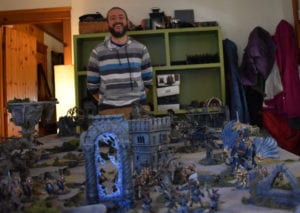
Across the field the sound of malevolent drums beat, making the sky pulse like a frantic heart. A dark and infernal energy swirls above the heads of the opposing army, the frayed host known as the Blades of Khorne. They stalk forward with axe in hand and slaughter on their minds. Dressed in obscene symbols and blood red armor, they pay tribute to a god of chaos that grants his disciples power as long as they only kill, maim and burn. The two armies clash up and down the field, as order and chaos struggle in an unremitting conflict.
Then Huntington resident Ian Craig takes a step back. That field of battle is just a table made from insulation foam and sand. The soldiers are just pieces of plastic less than 1/32 the scale of a human being. It’s all a game called Warhammer: Age of Sigmar, which uses dice and tape measurements to decide the outcome of a battle instead of martial prowess.
Craig is a professional miniature artist, and all those figures and terrain below him took hours upon hours of painstaking work to build and then paint, but it is a love for a craft he perfected since he was a kid, and a love of a game that has helped him find lifelong friends.
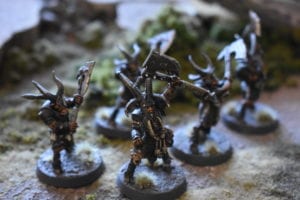
“That is what I enjoy most –— when you have this all together, the game transcends a board game, it becomes its own experience,” said Craig during a recent tour of his studio. “It’s really quite a different experience with that kind of beautiful terrain with those kinds of well-painted armies. One of the greatest things about this is we’ve lost, in general, so much of the connectivity between people.”
But it is perspective that matters. In terms of miniature war-gaming, looking at things at such a small scale, perspective is everything. The table and miniatures are so detailed because in it, while playing, everything becomes immersive. The game becomes more than a game; it becomes a narrative that unfolds with each decision and roll of the dice. “My favorite thing is sharing the hobby, and I think why I’m doing this primarily is because most people don’t get the full experience,” Craig explained.
Now the professional artist wants to turn a portion of his property into a gaming club, one that can facilitate all kinds of gamers, from old hands to young novices. Craig, who recently opened a painting studio called Old Well Miniature Studio in his home, said the game brings people together, and he envisions a space that has the beauty, narrative and immersion that makes the game come alive. “I want people to walk in, start playing and feel like they’re right in those books,” he stressed. “The place will be built to be an immersive experience.”
Until recently, Craig was a teacher at the nonprofit Love of Learning Montessori private school in Centerport, where his wife Lille has recently been named director. Ongoing seizures have forced him to leave teaching, and he misses the kids whom he got to know from first grade all the way to fifth grade. But this hobby-turned-profession has long been Craig’s way to look at things differently.
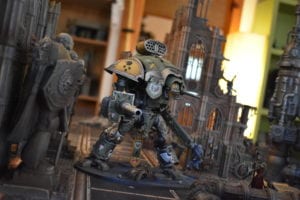
The setting of the game borrows elements from history, but plainly the entire thing is ridiculous. Warhammer’s tone in particular is so dark, despairing, yet ludicrous all at once. The game has been a way for the Huntington resident to enjoy something that does not take itself so seriously.
“It was my escape,” Craig said. “You can mirror your own life situations with that theme, then laugh at it and turn it into something humorous.”
It is a mindset that allows the artist to turn out project after project. Craig spent several years in the early 2000s as a miniature artist for Games Workshop, the company that makes Warhammer: Age of Sigmar and its sister product Warhammer 40,000.
“As an adult I got good at it,” Craig said. “I would go so far as to say it is not an obsession. It’s becoming a profession.” He is still working on his designs and is waiting for the necessary space to become available, but in the future, he already has plans for tournaments, community painting sessions and even after-school programs for kids.
Craig sees many advantages to learning a game like this, especially as a teacher. “You’re teaching fine motor skills, patience, math, reading comprehension to read these rules, interacting, being able to discuss something and come to a consensus, being able to communicate with different people, tactics and imagination, are all engaged on so many levels,” he said.
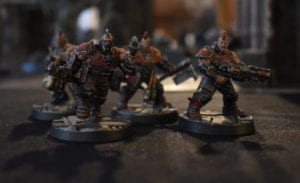
By next year Craig envisions the 1,500 square feet of space will make you feel like you’re stepping into another reality, straight out of a Tolkien-esque fantasy story. The space will include a downstairs area for war-games with multiple tables, and the upstairs for a role-playing game library, a separate rentable room for role-playing sessions and the ability to videotape and live stream games so they could post them online.
Even with all that work, Craig doesn’t plan to make much money for this venture, and only needs enough funds to keep the lights on because when all the miniatures are out on the table, with armor-clad warriors stomping through the brush, yelling battle cries and swinging axes the size of an average-sized human being, it reminds Craig what has made the whole thing such a lasting passion.
“There’s so much to this hobby that’s so good,” Craig said. “We have a community that needs something like this.”
‘What is the definition of a good wine? It should start and end with a smile.’
– William Sokolin
By Bob Lipinski
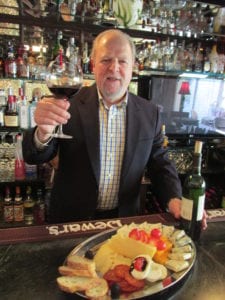
Zinfandel is a classic all-American grape variety, planted in virtually all of California’s grape-growing areas. It is a thin-skinned, medium-acid red grape with a mysterious past and has been grown throughout California for over 150 years. For decades it was believed that zinfandel came to the United States from Hungary in the mid-1860s. However, some 30 years earlier it was already growing in a nursery owned by William Robert Prince, now known as the Botanical Gardens in Flushing, Queens, New York.
In 1967, a U.S. Department of Agriculture plant pathologist first discovered the similarity of the Italian grape known as primitivo and zinfandel while in Bari, Italy. Italian researchers determined the primitivo grape had been grown in Apulia since the late 1700s. In 1976 a University of California scientist tested both grape varieties and determined them to be the same. That led researchers to Croatia where growers were convinced that zinfandel was the same grape variety as the local Plavac Mali. After further DNA testing it was revealed that Plavac Mali was not related to zinfandel. However, while the researchers were in Croatia, they heard stories about another indigenous grape that may in fact be the key to unlock zinfandel’s mystery.
In 2001, it was confirmed through DNA testing that zinfandel and an indigenous Croatian grape called Crljenak Kastelanski are the same. Additional research determined that Tribidrag is the oldest known Croatian name for the Crljenak Kastelanski grape variety, which appears in print as early as 1518.
George West from Massachusetts made California’s first white zinfandel at the El Pinal Winery near Stockton, California, in 1869; the first varietally labeled zinfandel was made in 1944 by the Parducci Winery; and the first rosé zinfandel was introduced in 1955 by Pedroncelli Winery. Sutter Home was the winery that defined and popularized the white zinfandel category and craze in the early 1970s.
The zinfandel grape’s history is not only fascinating but ponder this … winemakers can produce a white zinfandel, rosé zinfandel, red zinfandel, sparkling zinfandel, late-harvest zinfandel and port wine zinfandel.
A few recommended zinfandel wines I recently tasted are:
2015 Ravenswood “Dickerson,” Napa Valley
2015 Pedroncelli “Bushnell Vineyards,” Dry Creek
2014 Pedroncelli “Mother Clone,” Dry Creek
2017 Pedroncelli “Dry Rosé of Zinfandel,” Dry Creek
2016 Kreck “Teldeschi Vineyards,” Dry Creek
2016 Kreck “Del Barba Vineyard,” Contra Costa
2015 Kunde Estate Zinfandel, Sonoma Valley
2015 Kunde Reserve Century Vines, Sonoma Valley
Bob Lipinski is the author of 10 books, including “101: Everything You Need to Know About Whiskey” and “Italian Wine & Cheese Made Simple” (available on Amazon.com). He conducts training seminars on wine, spirits and food and is available for speaking engagements. He can be reached at www.boblipinski.com OR [email protected].
EVENING’S SWAN SONG
Elisa Hendrey of Sound Beach took this serene image at Mount Sinai Harbor on Sept. 30. She writes, ‘The lovely swan drifted right through the beam of sunlight on the water.’
Save the date!
Grounds & Sounds Cafe at Unitarian Universalist Fellowship, 380 Nicolls Road, East Setauket will welcome singer-songwriter Lara Herscovitch (modern American folk with blues, pop and jazz flavors) in concert on Friday, Oct. 12 at 9 p.m. Preceded by an open mic at 8 p.m. Tickets are $15 at the door or at www.groundsandsounds.org.
